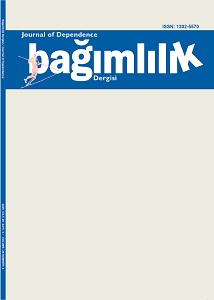The validity and reliability study of problematic internet use scale for adolescents
Keywords:
Problematic internet use, pathological internet use, internet addiction, adolescentAbstract
Objective: Nowadays, since internet is an important tool in social life, its unhealthy usage may lead to various problems in individuals’ lives. In this framework, various instruments for measuring problematic internet usage and internet addiction are available in literature, but it can be stated that the studies about this subject in Turkey is limited. In Turkey, there are the rapid increase in internet usage in general, and more specifically widespread usage of internet by adolescents and youths for various purposes. Therefore, development of an instrument for understanding the nature of adolescents’ internet usage behaviors has become a necessity. The current study aims to determine psychometric properties of Problematic Internet Usage Scale that was previously developed for university students by Ceyhan, Ceyhan and Gürcan (2007) for adolescents.
Method: The present study was carried out with 678 students who attend to the public high schools. Of these students, 571 students who reported that they use the internet more than 2 hours were included in the factor analysis. The data of the study were collected by Problematic Internet Usage Scale and Personal Information Questionnaire.
Results: Explanatory and confirmatory factor analyses indicated that scale for adolescents has three subfactors as negative consequences of the internet, excessive use and social benefit/social comfort. The construct with three factors under the 27 items explain the 49.35% of the total variance. Internal consistency of the scale (α) was found as 0.93. Internal consistency coefficients of the three factors were found as 0.93, 0.76 and 0.78, respectively.
Conclusion: According to findings, it can be stated that scale is valid and reliable. As a result, so called Problematic Internet Usage ScaleforAdolescents(PİKO-E)wasdeveloped.
References
Chou C, Condron L, Belland JC. A review of the research on internet addiction. Educational Psychology Review 2005; 17: 363-388.
Beard KW, Wolf EM. Modification in the proposed diagnostic criteria for internet addiction. Cyberpsychol Behav2001; 4: 377-383.
Dowling NA, Quirk KL. Screening for internet dependence: do the proposed diagnostic criteria differentiate normal from dependent internet use? Cyberpsychol Behav 2008; 12: 1-7.
Köroğlu G, Öztürk Ö, Tellioğlu N, Genç Y, Mırsal H, Beyazyürek M. Problemli internet kullanımıyla başvuran iki uçlu bir hasta nedeniyle psikiyatrik ek tanı tartışması: olgu sunumu. Bağımlılık Dergisi 2006; 7: 150-154.
Beard KW. Internet addiction: Current status and implications for employees. Journal of Employment Counseling 2002; 39: 2-11.
Young KS. Internet addiction: the emergence of a new clinical disorder. Cyberpsychol Behav 1998; 1: 237-244.
Öztürk Ö, Odabaşıoğlu G, Eraslan D, Genç Y, Kalyoncu A. İnternet bağımlılığı: kliniği ve tedavisi. Bağımlılık Dergisi 2007; 8: 36-41.
Bayraktar F. İnternet kullanımının ergen gelişimindeki rolü. Yayımlanmamış Yüksek Lisans Tezi, İzmir: Ege Üniversitesi, 2001.
Çakır Balta Ö, Horzum MB. Web tabanlı öğretim ortamındaki öğrencilerin internet bağımlılığını etkileyen faktörler. Ankara Üniversitesi Eğitim Bilimleri Fakültesi Dergisi 2008; 41: 187-205.
Davis RA, Flett GL, Besser A. Validation of a new scale for measuring problematic internet use: implications for pre-employment screening. Cyberpsychol Behav 2002; 5: 331-345.
Keser Özcan N, Buzlu S. Problemli internet kullanımını belirlemede yardımcı bir araç: internette Bilişsel Durum Ölçeği’nin üniversite öğrencilerinde geçerlik ve güvenirliği. Bağımlılık Dergisi 2005; 6: 19-26.
Ceyhan E, Ceyhan AA, Gürcan A. Problemli İnternet Kullanımı Ölçeği’nin geçerlik ve güvenirlik çalışmaları. Kuram ve Uygulamada Eğitim Bilimleri Dergisi 2007; 7: 387-416.
Günüç S. İnternet bağımlılık ölçeğinin geliştirilmesi ve bazı demografik değişkenler ile internet bağımlılığı arasındaki ilişkilerin incelenmesi. Yayınlanmamış Yüksek Lisans Tezi, Van: Yüzüncü Yıl Üniversitesi, 2009.
Türkiye İstatistik Kurumu. Hane halkı bilişim teknolojileri kullanımı araştırması 2007. Erişildiği site: http:// www.tuik.gov.tr/PreHaberBultenleri. do?ind=605. Erişim tarihi: 06.02.2008.
Ceyhan E. Ergen ruh sağlığı açısından bir risk faktörü: internet bağımlılığı. Çocuk ve Gençlik Ruh Sağlığı Dergisi 2008; 15: 109-116.
Valkenburg PM, Peter J. Adolescents’ identity experiments on the internet: consequences for social competence and self-concept unity. Communication Research 2008; 35: 208-231.
Valkenburg PM, Schouten AP, Peter J. Adolescents’ identity experiments on the internet. New Media & Society 2005; 7: 383-402.
Ward III DL. The relationship between psychosocial adjustment, identity formation, and problematic internet use. Unpublished Doctoral Dissertation. Proquest veritabanından edinilmiştir (UMI No. 9977896), 2000.
Ceyhan E, Ceyhan AA. Çocuk ve ergenlerde bilgisayar ve internet kullanımının gelişimsel sonuçları. Kuzu A. (editör). Bilgisayar. Eskişehir: Anadolu Üniversitesi Açık Öğretim Fakültesi Yayınları No: 958, 2008: 375-397.
Field A. Discovering Statistics Using SPSS. 2. Baskı, London: Sage Publications, 2005.
Şimşek ÖF. Yapısal eşitlik modellemesine giriş. Temel ilkeler ve LISREL uygulamaları. Ankara: Ekinoks Yayınevi, 2007.
Downloads
Published
Issue
Section
License
Copyright (c) 2025 Journal of Dependence

This work is licensed under a Creative Commons Attribution-NonCommercial-NoDerivatives 4.0 International License.
The Journal and content of this website is licensed under the terms of the Creative Commons Attribution-NonCommercial-NoDerivatives 4.0 International (CC BY-NC-ND 4.0) License. This is in accordance with the Budapest Open Access Initiative (BOAI) definition of open access. The Creative Commons Attribution-NonCommercial-NoDerivatives 4.0 International (CC BY-NC-ND 4.0) allows users to copy, distribute and transmit unmodified article, and make noncommercial use of the article. The CC BY license permits non-commercial re-use of an open access article, as long as the author is properly attributed.

